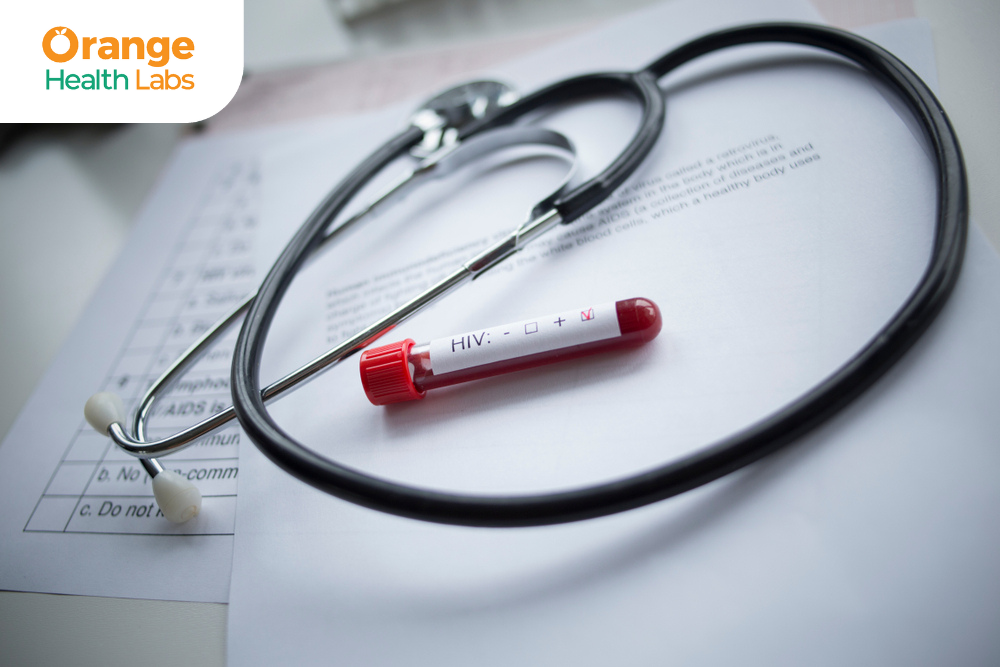Search for tests or checkups
SupportDemystifying the HIV Test – Everything You Need to Know

Introduction
HIV, or Human Immunodeficiency Virus, is a virus that attacks the body's immune system, weakening its ability to fight off infections and diseases. If left untreated, HIV can progress to AIDS (acquired immunodeficiency syndrome), a condition where the immune system is severely compromised, leading to life-threatening illnesses. Therefore, HIV test becomes a vital tool in enabling early detection of the virus and treating it. Early diagnosis not only allows the initiation of treatment promptly but also prolongs the life expectancy of individuals living with HIV. It also helps prevent the spread of infection within the community. In this article, we'll understand the importance of HIV testing, the different types of tests available, and what to expect when getting tested.
What Is an HIV Test?
An HIV test is a diagnostic tool used to detect the presence of HIV antibodies, antigens, or the virus itself in a person's body. The purpose of these tests is to determine whether someone has been infected with HIV. There are several types of HIV tests, including antibody tests, antigen/antibody tests, and nucleic acid tests, each with its own method of detecting the virus.
Why Is It Important to Get Tested?
Many individuals being infected with HIV may not even know as the disease may remain asymptomatic. Early detection of HIV holds significance for several reasons. Firstly, it allows for early initiation of treatment, which can significantly improve health outcomes and prolong life expectancy. Secondly, knowing one's HIV status can help prevent the spread of the virus to others through adopting safer sexual practices and seeking appropriate medical care. It can also help during pregnancy planning and prevent transmission of the virus to the babies. Lastly, getting tested for HIV is essential for personal health management, as it enables individuals to take proactive measures to protect their health and remain risk-free.
Who Should Get Tested for HIV?
Everyone, regardless of age, should consider getting tested for HIV, especially those who engage in behaviours that put them at higher risk of infection, such as unprotected sex or sharing needles. The Centers for Disease Control and Prevention (CDC) recommends annual routine HIV testing for individuals of 13-64 years. It also emphasizes testing for individuals with specific risk factors such as men who have engaged in sexual activity with other men, those who have had anal or vaginal intercourse with HIV-positive partners, individuals with multiple sexual partners since their last HIV test, and those who have shared needles or drug injection equipment. Pregnant women should also seek HIV testing and protect their babies from HIV infection.
Types of HIV Tests Available
Rapid Antibody Tests
The rapid antibody test for HIV is a simple and quick screening method that detects antibodies produced by the body in response to HIV. It typically involves collecting a small blood sample through a finger prick or oral fluid sample via a swab inside the mouth. Results are available within minutes, making it a convenient option for testing in various settings, including clinics, community centres, and even at home. If tested positive with these, the individual, however, requires further testing to confirm the diagnosis.
Combination or Fourth-Generation Tests
The fourth-generation tests are considered as gold standard for HIV testing. They combine antibody and antigen testing, allowing for earlier detection of HIV infection compared to previous antibody-only tests. This test offers better accuracy and earlier diagnosis. Additionally, they can differentiate between HIV-1 and HIV-2 infection. These tests can be taken in healthcare facilities, government centres, and HIV service centres.
PCR Tests (Viral Load Tests)
An HIV viral load test measures the amount of HIV in your blood through a molecular test known as nucleic acid amplification, or PCR, test. The test involves a blood sample typically taken from a vein in the arm, with results indicating the level of the virus in the blood. A negative or undetectable result suggests effective treatment, while a high viral load may indicate the need for medication adjustments. Regular testing is recommended for those living with HIV to monitor infection and treatment progress.
Understanding HIV Test Results
Understanding your HIV test results and what to do next is crucial for your health. The turnaround time for test results typically varies for each one of them. Rapid tests can provide results in as little as 20 minutes, while PCR/ NAT tests, which have the shortest window period for detecting HIV after exposure, also may take several days. The results of an HIV test can either be positive or negative.
If the result is positive, confirmatory testing is necessary unless you have taken a PCR test. Your healthcare provider will then assist in initiating a suitable treatment for you. A PCR test may be advised to understand the viral load. The results are expressed as high and low viral load. They are significant while initiating treatment for HIV once tested positive. Additionally, it's crucial to inform your sexual partner(s) about your diagnosis so they can also seek testing and support.
A negative result means the test didn't detect signs of the virus, but it's essential to consider retesting, if necessary. Even with a negative result, it's vital to understand the preventive measures and get retested regularly.
An HIV result may be indeterminate. This means that the test didn't provide a clear negative or positive result. This could be due to early HIV infection, where the result falls between negative and positive, or it might be caused by a different viral infection or nonspecific antibodies. When this happens, it must be followed by a repeat testing.
How to Prepare for an HIV Test
Preparing for an HIV test at home is straightforward. Usually, there's no special preparation required for the test. If you opt for a testing facility or get at-home testing, a staff member will provide details on the sample collection process. Meanwhile, for at-home self-testing kits, carefully adhere to the instructions enclosed with your testing kit.
For blood tests drawn from a vein, the professional will use a small needle to collect a blood sample from your arm. You might feel a slight sting during needle insertion, but the process typically lasts less than five minutes. Alternatively, for blood drawn from a finger, a specialized tool called a lancet will be used to prick your finger and obtain the sample. When collecting a saliva sample, the healthcare professional will gently swipe a specialized swab along your gums to collect the sample. If self-collection of sample is required for testing, follow the instructions provided with your collection kit.
Conclusion
In conclusion, HIV testing is an essential aspect of public health and personal well-being. It provides individuals with the opportunity to know their HIV status, enabling early diagnosis and access to necessary medical care and treatment. By understanding the importance of HIV testing and taking proactive measures to get tested regularly, individuals can protect their health, prevent the spread of HIV, and contribute to the collective effort in combating the HIV/AIDS epidemic.
Book HIV Test in your city: HIV Test in Mumbai | HIV Test in Bangalore | HIV Test in Noida | HIV Test in Hyderabad | HIV Test in Gurgaon | HIV Test in Faridabad | HIV Test in Delhi

From T3 to Thyroid Health: A Comprehensive Guide to Triiodothyronine

The Emotional Journey of Getting an HIV Test: What to Expect
